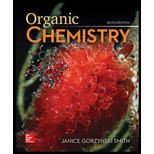
Concept explainers
(a)
Interpretation: Whether the given statement is true for a reaction with
Concept introduction: The activation energy
The change in Gibbs free energy, enthalpy and entropy is represented by
The change in Gibbs free energy describes the spontaneity of the reaction. The change in enthalpy describes the relative bond strength in the substance, whereas the change in entropy describes the randomness in the system.
(b)
Interpretation: Whether the given statement is true for a reaction with
Concept introduction: The activation energy
The change in Gibbs free energy, enthalpy and entropy is represented by
The change in Gibbs free energy describes the spontaneity of the reaction. The change in enthalpy describes the relative bond strength in the substance, whereas the change in entropy describes the randomness in the system.
(c)
Interpretation: Whether the given statement is true for a reaction with
Concept introduction: The activation energy
The change in Gibbs free energy, enthalpy and entropy is represented by
The change in Gibbs free energy describes the spontaneity of the reaction. The change in enthalpy describes the relative bond strength in the substance, whereas the change in entropy describes the randomness in the system.
(d)
Interpretation: Whether the given statement is true for a reaction with
Concept introduction: The activation energy
The change in Gibbs free energy, enthalpy and entropy is represented by
The change in Gibbs free energy describes the spontaneity of the reaction. The change in enthalpy describes the relative bond strength in the substance, whereas the change in entropy describes the randomness in the system.
(e)
Interpretation: Whether the given statement is true for a reaction with
Concept introduction: The activation energy
The change in Gibbs free energy, enthalpy and entropy is represented by
The change in Gibbs free energy describes the spontaneity of the reaction. The change in enthalpy describes the relative bond strength in the substance, whereas the change in entropy describes the randomness in the system.
Want to see the full answer?
Check out a sample textbook solution
Chapter 6 Solutions
ORGANIC CHEMISTRY (LOOSELEAF)
- For the reaction shown, which of the following answers best describes the product(s) of this reaction? Choose one answer OH م Br, OH Br₂ H₂O 25 °C Br HO Br b) Br, "11 OH Br Br + HO Br Br Brarrow_forwardFf.268.arrow_forwardWhat is the final product (B) of the following reaction? CH3 Br2 1. KCN light → B 2. H30*, heat CH3 CO2H CO,H CH3 CH2CO2H (a) (d) `CO2Harrow_forward
- For the following reactions, predict the likely product(s) of the reaction or write 'no reaction." Me H Me °x Me Me Me Br Me Me Me Nal, NaOCI EtOH, H₂O HNO3 ACOH AICI 3arrow_forwardG.204.arrow_forwardFor each case below determine whether the products or reactant are favored A reaction of K eq=10 A reaction of K eq = 0.01 A reaction of negative delta Garrow_forward
- 1. 1a) 1b) 1c) 1d) For each of the following reactions: Draw a reaction mechanism (curved arrows) and comeplete the reaction on the right side. Then predict which side of the equilibrium is favored, left, right or either. Circle the stronger acid. If the strength are euqal, circle both. Give one word from the HIRE rules to state the most important factor in your determination and put it in the box. O N SH + F3C OH + + _N_ + OH Oo. 8arrow_forwardCalculate A,H for the following reaction: 5C(s) + 6H2(9) → C5H12(1) Use the following reactions and given ArH's. C5H12 (1) + 8 O2(g) → 5CO2(g) + 6H2O(g), A;H = -3505.8 kJ mol C(s) + 02(g) → CO2(g), ArH = -393.5 kJ mol1 2H2(g) + O2(9) → 2H2O(g) , A¡H = -483.5 kJ molarrow_forwardN-benzylethanamide Draw the molecule on the canvas by choosing buttons from the Tools (for bonds), Atoms, and Adv toolbars. The single bond is active by default. DC H 12D EXP. CONT. Gl · [1] A ZI CH3 H с N S CI Br I P Farrow_forward
- Now consider the following reaction: C2H5OH + 3O2→2CO2+ 3H2O ,ΔH=−1370 kJ/mol What is the enthalpy for the reaction reversed? reaction 1 reversed: 2CO2 + 3H2O→C2H5OH + 3O2arrow_forwardFor a reaction with ΔHo = 40 kJ/mol, decide which of the following statements is (are) true. Correct any false statement to make it true. (a) The reaction is exothermic; (b) ΔGo for the reaction is positive; (c) Keq is greater than 1; (d) the bonds in the starting materials are stronger than the bonds in the product; and (e) the product is favored at equilibrium.arrow_forward(a) Predict the products of the following acid-base reactions using curved-arrow mechanisms to indicate electron flow. (b) Indicate the acid, base, conjugate acid, and conjugate base of each reaction. (c) Indicate whether the reactants or products are favored at equilibrium a) CH,COOH CH3O b) CH,CH,OH H2Narrow_forward
 Chemistry: The Molecular ScienceChemistryISBN:9781285199047Author:John W. Moore, Conrad L. StanitskiPublisher:Cengage Learning
Chemistry: The Molecular ScienceChemistryISBN:9781285199047Author:John W. Moore, Conrad L. StanitskiPublisher:Cengage Learning
 Organic ChemistryChemistryISBN:9781305580350Author:William H. Brown, Brent L. Iverson, Eric Anslyn, Christopher S. FootePublisher:Cengage Learning
Organic ChemistryChemistryISBN:9781305580350Author:William H. Brown, Brent L. Iverson, Eric Anslyn, Christopher S. FootePublisher:Cengage Learning


